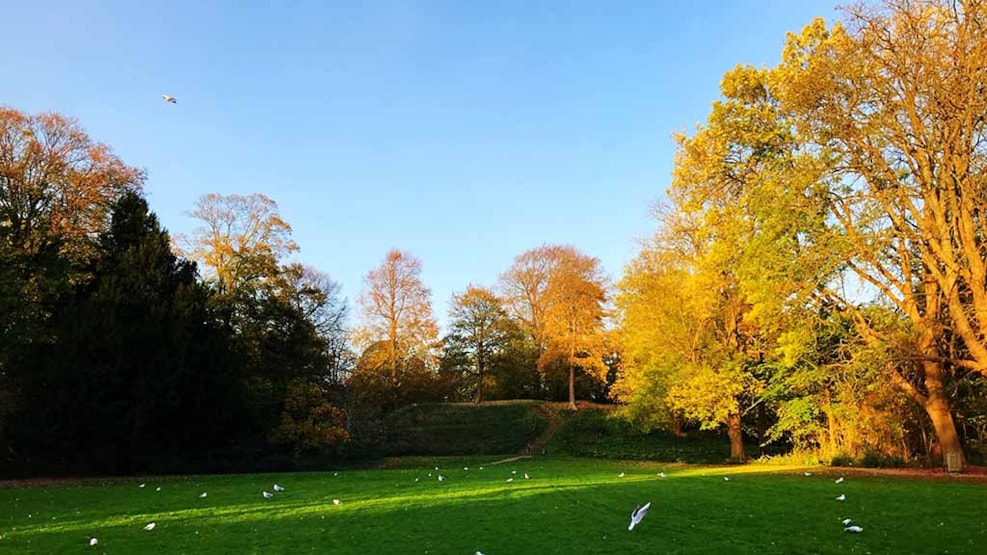
King Erik Menved's Castle
In a quiet corner of Bygholm Park, a very popular park in Horsens, you come across the hill called Slangebjerg. On this very ground, in the turbulent year of 1313, King Erik Menved built a castle to defend himself against rebellious, Jutlandic farmers. Today, remnants of the building foundations and moats can be seen by the public on Slangebjerg.
The castle site in Bygholm Park
In a clearing in Bygholm Park, not many steps from the Hotel, Comwell Bygholm Park, lies an artificially constructed castle mound from the 14th century, partially hidden by trees and vegetation.
The park, now brimming with peace and serenity, stands in acute contrast to the period in which the castle was built. Back then, the situation in Denmark was chaotic, with peasants and nobility repeatedly engaging in bloody power struggles against the crown. Bygholm Castle was built by Erik Menved to defend the crown during these tumultuous times.
The castle towered over the landscape on an artificially constructed mound, making it possible to monitor threats from far away. The castle was three-winged, each wing measuring between 20 and 30 meters, and two stories high, built in a half-timbered construction. Additionally, remains of a castle wall have been discovered – and a nearby barn, linked to the castle by a bridge. The castle was also surrounded by a large moat.
The enforced castle of Erik Menved
In Denmark, the 14th century has been referred to as "the century of castles". The crown was facing threats, not only from other power structures and sovereignties, but also from internal uprisings orchestrated by the nobility and peasants. Hence, a strong defence was required – not only for the crown, but also for its enemies. Therefore, across the landscape, you can still see remnants of defensive structures from this tumultuous time. In fact, the conflict was so severe that Denmark, for a notable period in the 14th century, was entirely without a monarch.
The reign of Erik Menved lasted from 1287 to 1319. In the early 14th century, his power was challenged by an uprising from Jutlandic peasants. He, subsequently, lost a battle in Kolding just before commencing his work on the castle. To retaliate, he gathered a new army of mercenaries and struck back. Moreover, to protect himself from future attacks, he forced the peasants to pay heavy taxes and yield their labour to constructing several new Danish castles which would, ironically enough, keep the king safe from the peasants themselves.
Bygholm was one of these four enforced castles. The remaining three were constructed at Kalø, Bornholm, and Viborg – all of which make up major tourist attractions today. These four castles served as residences for the king during his travels around the country.
The demolition of the castle
Throughout the 14th century, the castle played a significant role in the country’s defence. Not least of all in 1348, when King Valdemar Atterdag took back the country, which, due to debt, had been pawned off. In the following, more peaceful, centuries of Danish history, the noble family Gyldenstjerne had ownership of the castle. By the 17th century, the castle had been worn out and consequently, in 1617, it was ordered to be demolished.
At Bygholm, the Bygholm Manor was built instead, just a few hundred metres from the castle mound. The manor can still be seen in the park today. It now operates as a hotel.
Want to visit the castle ruin?
The castle mound Slangebjerg is located in Bygholm Park. Parking is available at the large public parking lot, accessible from Bygholm Parkvej, near Schüttesvej. From here, walk north through the park, past the playground and the hotel. The mound is located northeast of the manor’s main building.
Bygholm Park can also be accessed from the city centre by using the train station tunnel.
The park features two nice playgrounds, a disc golf course, and ample opportunity to enjoy a prepacked lunch at the many tables and benches. At certain times of the year, you are also able to enjoy a meal or a cup of coffee in the restaurant of the hotel. Adjacent to the park is the nature area Bygholm Lake, which is quite popular among hikers.
On this site, you can read more about Bygholm Park.
Looking for more historical attractions?
Kystlandet offers many exciting historical attractions, ranging from ancient to industrial history, from museums to buildings, and of course, attractions in nature. On this site, you find inspiration for other historically interesting experiences near Horsens, Odder, and Juelsminde.
Some findings from the excavations at the Bygholm castle ruins can also be seen today at Horsens Museum.